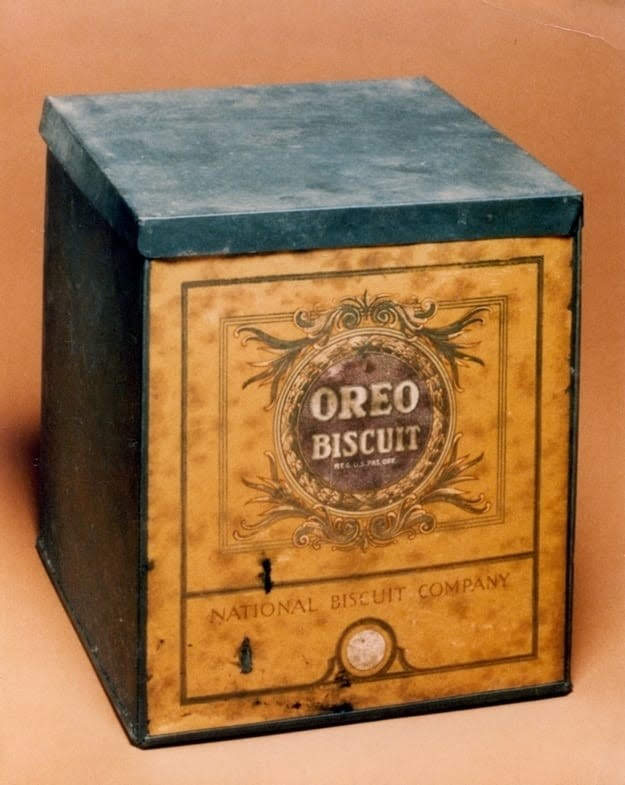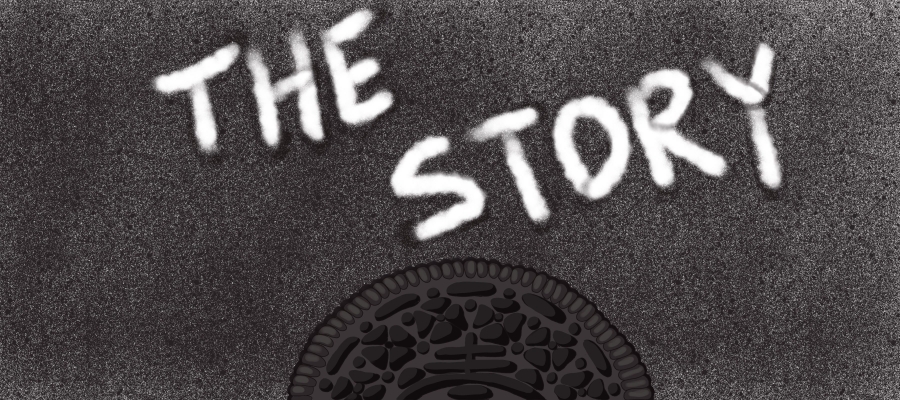The Oreo cookie is the only cookie that I, as an adult, still buy from the snack foods aisle. Shockingly, this cookie is over a hundred years old!

In 1912, the National Biscuit Company announced the release of 3 high end cookies - they referred to them as the “Trio”. The 3 high end cookies were 1. The Mother Goose Biscuit, 2. The Veronese Biscuit, and 3. The Oreo Biscuit.
The Oreo, of course, became a very successful cookie that we are still eating over a hundred years later. And, of course, it has changed over time. Everything from the design on the Oreo, to the ingredients used to make the Oreo, and the Oreo packaging have changed. When it was first sold, Oreo came in really boxy tins. People have described the original Oreo tins as being yellow or gold colored, with the lettering being gold. This is important to mention because this description has led people to theorize that the name “Oreo” came from the French word for gold, which is “or”. That’s just one of several theories on where the name “Oreo” came from, and we discussed these theories with Stella Parks who wrote the book “BraveTart: Iconic American Desserts”. This book won the 2018 James Beard Foundation Book Award.
The French-word-for-gold theory is a bit of a stretch. As Stella explains it, if Oreo's name was related to the French word for gold then this would have likely been a reference we would have seen in advertisements, but the ads did not refer to gold at all. Many other theories are just as unlikely to be true. Some people have said that the name "Oreo" was derived from the word "orexigenic" - an orexigenic is something that stimulates the appetite. Another theory is that the name Oreo represents the construction of the cookie. So imagine that the two O’s are meant to be the two cookies sandwiching the cream, and the “re” in the middle of the spelling O-r-e-O is meant to be the cream, because “r, e” are the 2 letters in the middle of the word “cream”. There's also the theory that Oreo comes from the Greek word for “hill” because some early version of the Oreo was supposedly dome-shaped like a hill.

Stella Parks has her own theory. This one makes perfect sense. Stella recognized that companies tend to name their products using a common theme, so she looked for a theme in The National Biscuit Company's product names. She took a look at the names of the National Biscuit Company's products from around Oreo's time. She noted that many of the products were given names related to plants. For example, one biscuit was named Lotus - the lovely flower that grows in water gardens. Another biscuit was named Avena, after oats. Another biscuit was named Zaytona, which could have come from the Arabic word for olive. There was also a biscuit called Anola, likely because one of its ingredients was canola. You get the picture. Following that trend, it makes sense that the name Oreo came from the word “Oreodaphne” which is a genus of flowering plants. So the wreath design on the original Oreo could very well have been made up of a plant from the genus Oreodaphne.
So the name "Oreo" likely comes from the word Oreodaphne - a genus of plants that includes evergreen trees which are sometimes called Mountain Laurels. So now the question is - why name the Oreo after, basically, mountain laurels? Well, a few years before the Oreo came out, there was already a cookie on the market with a wreath design pressed into a dark cookie, sandwiching a cream filling. This cookie was called Hydrox. So the Oreo cookie was The National Biscuit Company’s copy of the Hydrox cookie, which was sold by the Loose-Wiles Biscuit Company...later renamed as Sunshine Biscuits.
So, let’s summarize what we’ve learned. The Oreo cookie is likely named after the Oreodaphne in relation to the decoration on the original Oreo cookie, which was likely a mountain laurel wreath, which was the same type of plant decorating the original Hydrox cookie, which was the cookie Oreo was copying.
The Hydrox cookie was visually stunning for its time. The level of detail of the image pressed onto the cookie was amazing for a time when bakeries were still changing from being small businesses to large factories. For the Loose-Wiles Biscuit Company, the Hydrox was an all-star cookie, and Oreo copied it.
And there’s a lot more to the story than that. Let's go back in time a bit to talk about the creation of the Loose-Wiles Biscuit Company. The National Biscuit Company (now known as the shortened name, Nabisco, Na (for national) bis (for biscuit) co (for company)) - was formed from a merger between 3 huge companies - The New York Biscuit Company, The United States Baking Company, and The American Biscuit and Manufacturing Company. That last one was run by 2 brothers - Jacob and Joseph Loose. When the merger happened, Jacob Loose did not agree with it, and left the company to start the Loose-Wiles Biscuit Company (which he founded with John Wiles).
That means that Jacob’s brother, Joseph Loose was still at The National Biscuit Company when Jacob went off to form another company - the Loose-Wiles Biscuit Company. Two brothers at two competing companies. (Note that at some later point, Joseph Loose eventually joined with his brother Jacob's company.) Imagine Jacob Loose, once again starting a biscuit company, competing with a company led by his own brother, as well as many of the people he used to work with - you can imagine that he had a lot to prove. So Jacob's company launched the Hydrox cookie and it was a great success.
But a few years later, The National Biscuit Company came out with practically the same cookie - this was the Oreo. They very similarly adorned the Oreo with a fancy design in a wreath pattern around the company name, they advertised with a similar slogan, and as the author Stella Parks noted, they launched it on the Loose-Wiles Biscuit Company’s 10th anniversary.
When Oreo launched, Hydrox was still the ruler of its cookie category. But the National Biscuit Company was a very overwhelming competitor to go against - it was a behemoth. So while the Hydrox was beloved, there were a few things going against it. The National Biscuit Company had many marketing dollars to throw at Oreos, and the name Hydrox eventually became associated with chemicals because it was a word also used by chemical companies. (The name Hydrox was just the words hydrogen and oxygen mashed together - it was meant to make people think of purity, pure like water, H2O). They tried changing the name Hydrox to Droxies to move away from the chemical association, but that didn't help.

Even though Oreo was the copycat cookie, over time people started to believe that Hydrox was the copycat cookie. Eventually, Hydrox was discontinued. However, it was brought back by Leaf Brands in 2015 and today it continues to struggle against Oreo. We spoke to the CEO of Leaf Brands - Ellia Kassoff - and he explained to us how he worked to recreate the recipe of the original Hydrox cookie. Hydrox still has its fans and when they learned about its revival, many people contacted Ellia to help out. Some people had been suppliers to the company that made Hydrox, some people had worked in factories that had made Hydrox, and some people had eaten Hydrox cookies as customers. With all the knowledge from different people that had known the Hydrox cookie, Leaf Brands was able to recreate the cookie.
We also spoke to Bill Turnier, the son of William Turnier who is credited by many as the designer of the current Oreo design. Although the first Oreo cookie was a copy of Hydrox, the latest design of the Oreo has its very own story to tell. As Bill Turnier told us, his dad worked his way up from the mail room at Nabisco to being the assistant to the chief cookie designer - William Turnier worked at Nabisco for 49 years before retiring at age 65.
Special Thanks To Our Interviewees:
Stella Parks - author of "BraveTart: Iconic American Desserts"
Ellia Kassoff - CEO of Leaf Brands
Bill Turnier - son of William Turnier (widely credited as the designer of the latest Oreo cookie)

